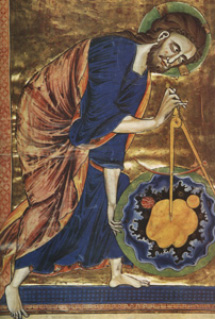
 “In creating the world, God used arithmetic, geometry,
and likewise astronomy.” – Nicholas of Cusa (click here for
article)
“In creating the world, God used arithmetic, geometry,
and likewise astronomy.” – Nicholas of Cusa (click here for
article)
Metaphors and Models of Scientific Thought
As an example of creative scientific work being accomplished with an interaction metaphor, consider how, in the 1860s, James Clerk Maxwell arrived at his electromagnetic field equations along the following lines:
The electromagnetic field behaves as if it were a collection of wheels, pulleys and fluids.
Here, the instrument of the metaphor – as if – signals
a mapping from the secondary subject (the well-understood Newtonian mechanics
of wheels, pulleys, and fluids, with its associated visual imagery with
a means for translating mechanical terms into electromagnetic ones) toward
exploring the poorly understood primary subject (electromagnetic field).
Figure 1 is Maxwell’s representation of a mechanical device that
provides the mathematics for the metaphor’s secondary subject. Here,
according to Maxwell, “electrical current is represented” by
the motion of small particles that have almost no mass and are spread out
between neighboring vortices.
Although the speculative ‘as if’ is
essential here, as in every metaphor to be explored in this chapter, Maxwell’s
metaphor is a model. In Maxwell’s case, for several reasons, the
tension is weak between the primary and the secondary subjects. The secondary
subject is not far removed from what was well known in the 1860s. In that
era British scientists sought specifically to express their thinking
in visual modes based on apparatuses that were, in principle, constructible
and socould be actually experienced. Besides,
no one believed that the electromagnetic field really has
anything to do with wheels and pulleys. This is why Maxwell’s metaphor
is a model and his reasoning is referred to as analogical.
Miller, Arthur I. Insights of Genius: Imagery and Creativity in Science and Art, Springer-Verlag 1996, pp. 221-222.

